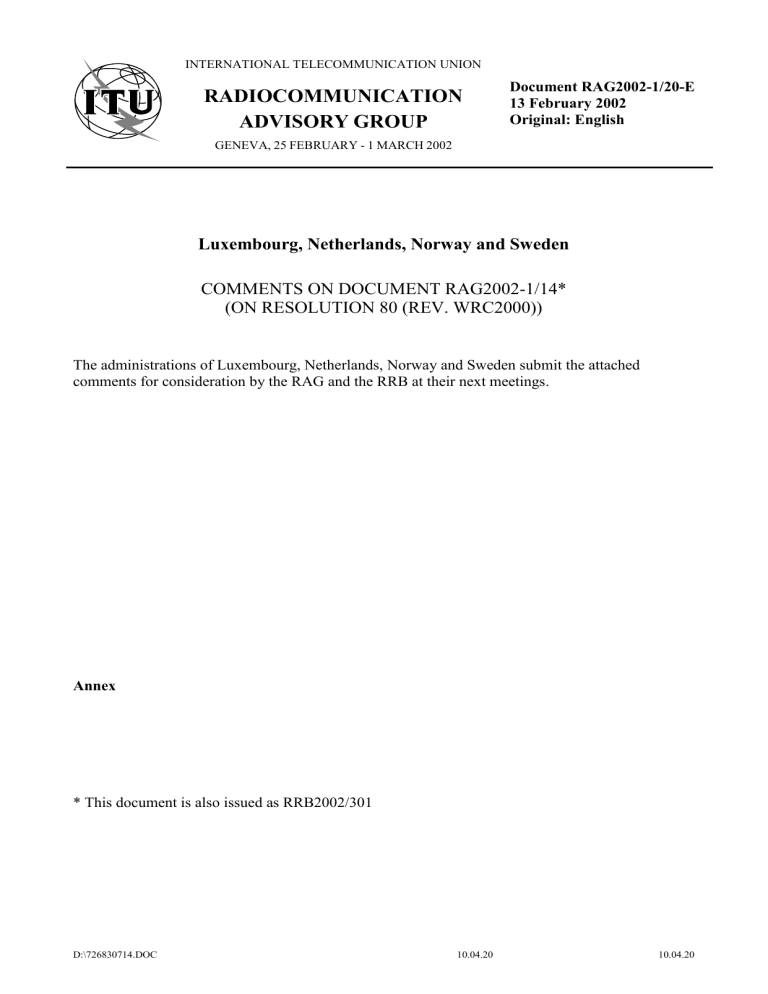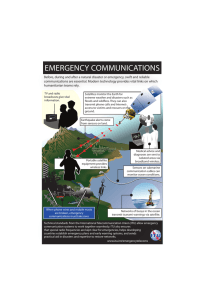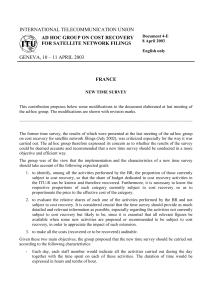RADIOCOMMUNICATION ADVISORY GROUP

INTERNATIONAL TELECOMMUNICATION UNION
RADIOCOMMUNICATION
ADVISORY GROUP
GENEVA, 25 FEBRUARY 1 MARCH 2002
Document RAG2002-1/20-E
13 February 2002
Original: English
Luxembourg, Netherlands, Norway and Sweden
COMMENTS ON DOCUMENT RAG2002-1/14*
(ON RESOLUTION 80 (REV. WRC2000))
The administrations of Luxembourg, Netherlands, Norway and Sweden submit the attached comments for consideration by the RAG and the RRB at their next meetings.
Annex
* This document is also issued as RRB2002/301
D:\726830714.DOC 10.04.20 10.04.20
- 2 -
RAG2002-1/20-E
ANNEX
Comments on Document RAG2002-1/14
The previously named administrations have read the document with considerable interest and concern. As the issues raised have considerable implications on the Radio Regulations and the usage of the orbit/spectrum resources by all administrations and satellite operators, it is important that this matter be given thorough consideration before any decisions are taken. We have not yet had the time to study all of the various implications and develop detailed and comprehensive comments on all of the proposals contained in the document. In many cases the proposals are not clear and comments could only be provided once there is some clarification and explanation of the various proposals.
The following are some general comments and concerns on some of the specific proposals:
No. 1 : How does one determine if the specific project is genuine, when the financing is secured? That is often too late to start the filing process and coordination. Having some status in the ITU process is often part of the process in obtaining financing and approval to provide service.
No. 2 : The principle of priority processing appears to allow one network of an administration, which has no satellite networks recorded in the Master International
Frequency Register, to bypass all the satellite networks in the coordination process. It is understood that this principle would in fact not only relate to a priority in the processing, but also a priority in the rights. This would introduce arbitrary and unknown constraints in the planning of all satellite networks until the notification stage, hence no possibility of financing for all satellite networks. In addition does this mean that an implementation schedule will have to be filed with the ITU and the ITU will judge whether that schedule is being kept. If so how does the ITU make such judgments considering that during the planning of a satellite network, the schedule has to be revised for very valid reasons.
Nos. 4 and 5 : These are already implemented in the RR so it is not clear what different approach is being proposed.
No. 7 : This proposal seems to go against Res. 4, which specifies that replacement satellite must have the same characteristic as the original satellite.
Nos. 7, 8 & 9 : Under No. 9, there is a demand for greater transparency and precision in the submission and updating of network data relating to spectrum/orbit resources. There is a large element of duplication here because much of this information already becomes available under the current procedures. Greater openness in sharing information on the progress of satellite networks can indeed bring a useful degree of self-discipline in planning satellite networks and in exposing cases of unrealistic projects. However, the effects of
Nos. 7 and 8 under this regime will be prejudicial to any administration that admits to implementation delays and difficulties, many of which are completely unpredictable and beyond the control of administrations. The overall effect is that administrations will become more guarded when presenting such information. The combined effects of No. 9 coupled with Nos. 7 and 8, possibly Nos. 2, 3 and 6 as well, will lead to a reduced flow of information and will therefore be counter-productive to the objective of sharing accurate information on the progress of satellite networks.
D:\726830714.DOC 10.04.20 10.04.20
- 3 -
RAG2002-1/20-E
No. 11 : How is the ITU to judge the situation and whether the reasons are good?
No. 12 : It is not clear how this proposal differs from the present procedures, except with respect to the priority processing which needs to be better understood (see comments under
No. 2).
No. 13 : This proposal is open to different interpretations. One such interpretation is that if an administration notifies at the end of the 5 year plus the 2 year extension period, it has another 3 years to bring the assignments into use (a total of 10 years). Another interpretation is that if an administration notifies within 3 years of the in-service date within the basic time limit of 5 years, this proposal would seem to then preclude the application of the provisions for a 2-year extension of the time limit.
No. 14 and some others : It is difficult to provide specific comments as the intent and the process of the proposals are not clear.
____________________
D:\726830714.DOC 10.04.20 10.04.20

